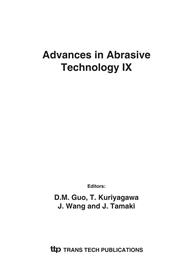[1]
R.E. Phillips: What Is Electrochemical Grinding and How Does It work, Carbide and Tool Journal Vol. 18 (1986), pp.12-14.
Google Scholar
[2]
J.A. Mc Geough: Principles of Electrochemical Machining (1974), pp.1-10.
Google Scholar
[3]
V. K. Jain and V.N. Nanda: Analysis of Taper Produced in Size Zone during ECD (Precision Engineering, Vol. 8, 1986), pp.27-33.
DOI: 10.1016/0141-6359(86)90007-3
Google Scholar
[4]
A.R. Mileham, S.J. Harrey and K.J. Stout: The Characterization of Electrochemically Machined Surfaces (Wear, Vol. 109, 1986), pp.207-214.
DOI: 10.1016/0043-1648(86)90265-6
Google Scholar
[5]
M.A. Bejar, et al.: On the Determination of Current Efficiency in Electrochemical Machining with a Variable Gap (J. Mat. Proc. Tech., Vol. 37, 1993), pp.691-699.
Google Scholar
[6]
W.M. Shen: The Study of Polishing of Electric Discharge-Machined Mold With ECM. (M. Sc. Thesis, National Yunlin Institute of Techndogy, Taiwan 1995).
Google Scholar
[7]
L. Cagnon, V. Kirchner, M. Kock, R. Schuster, G. Ertl, W.T. Gmelin, and H. Kuck: Electrochemical miromachining of stainless steel by ultra short voltage pulses (Z. Phys. Chem. Vol. 217, 2003), pp.299-313.
DOI: 10.1524/zpch.217.4.299.20383
Google Scholar
[8]
H. Hocheng, and P.S. Pa: Electropolishing of Cylindrical Workpiece of Tool Materials Using Disc-Form Electrodes (Journal Materials Processing Technology, Vol. 142, 2003), pp.203-212.
DOI: 10.1016/s0924-0136(03)00599-5
Google Scholar
[9]
P.S. Pa, and H. Hocheng: Using Borer-Shape Electrode in Electrochemical Smoothing of Holes (Materials Science Forum, Vol. 505-507, 2006), pp.793-798.
DOI: 10.4028/www.scientific.net/msf.505-507.793
Google Scholar
[10]
B.H. Kim, S.H. Ryu, D.K. Choi, and C.N. Chu: Micro electrochemical milling (Journal of Micromechanics and Microengineering, Vol. 15 2005), pp.124-129.
DOI: 10.1088/0960-1317/15/1/019
Google Scholar
3 workpiece electrolyte flow electrolyte flow electrode rotation s0. 03 0. 3 workpiece electrolyte flow electrolyte flow electrode rotation s0. 03 feeding direction (a) System Schematics (b) Configuration of Tool and Workpiece Fig. 1 Experimental Set-Up (� Requirement • Design Feature) Fig. 2 Development of Electrode Design (Wt %) Fe C Si Mn P S Cr Mo Al V Cu Ni AISI H13 (SKD61) 90. 70 0. 38 0. 96 0. 43 0. 29 0. 03 5. 31 1. 08 / 0. 82 / / AISI D2 (SKD11) 88. 65 1. 40 0. 40 0. 30 0. 02 0. 03 8. 20 0. 80 / 0. 20 / / AISI P21 (NAK80) 92. 06 0. 13 0. 60 1. 50 / / / 0. 25 1. 12 / 1. 24 3. 1 AISI 4340 (SNCM439) 96. 48 0. 39 0. 30 0. 90 0. 02 0. 03 0. 80 0. 25 / / 0. 03 2. 0 � Short-time Polishing • Completely Inserted Electrode • Feeding Electrode � Eliminating Secondary Overcut � Increasing Effective Current Density � Large Discharge Space • Plate Form Electrode • Borer Type Electrode � Increasing Discharging Mobility • Pulse Direct Current • Single-Plate • Single-Borer φ16 30 30 R8 30 4 φ16 30 R8 4 Type A Type B Type C Type D (a) Inserted Electrodes 16φ 8 16 4 φ 8 4 Type A Type B Type C Type D (b) Feeding Electrodes Fig. 3 Design of Electrode Fig. 4 Electrochemical finishing with different types of inserted electrode at 0. 02mm of radial depth (4l/min, continuous DC, 30A/cm 2 ) AISI 4340 AISI P21 AISI D2 AISI H13 0.
Google Scholar
[1]
6 0 0. 5 1 1. 5 2 2. 5 3 3. 5 4 4. 5 5 5. 5 6 Time (sec) Ra (µm) type A 600rpm type B 600rpm type C 600rpm type D 600rpm 0.
Google Scholar
[1]
3 Ra (µm) continuous 100/100 100/200 100/300 100/400 100/500 ON/OFF Time (ms/ms) Fig. 5 Electrobrightening with different types of electrode at continuous and pulsed direct current (SKD61, 4l/min, DC, 30A/cm2, ON Time 3 sec) type A (600rpm) type B (600rpm) type C (600rpm) type D (600rpm) Fig. 6 Electrochemical finishing with different feed rate of electrode through different current rating (AISI H13, Type A, 600rpm, NaNO3, 25wt%, 4l/min, Continuous DC) 0.
DOI: 10.17816/kazmj70902-38627
Google Scholar
[1]
5 0 2 2. 5 3 3. 5 4 4. 5 5 Feed Rate (mm/min) Ra (µm) 5A 10A 15A 20A 0.
Google Scholar
9 1 Ra (µm) type A type B type C type D Fig. 7 Electrochemical finishing with different types of feeding electrode (AISI H13, 4l/min, Continuous DC, 10A, 4mm/min).
Google Scholar


